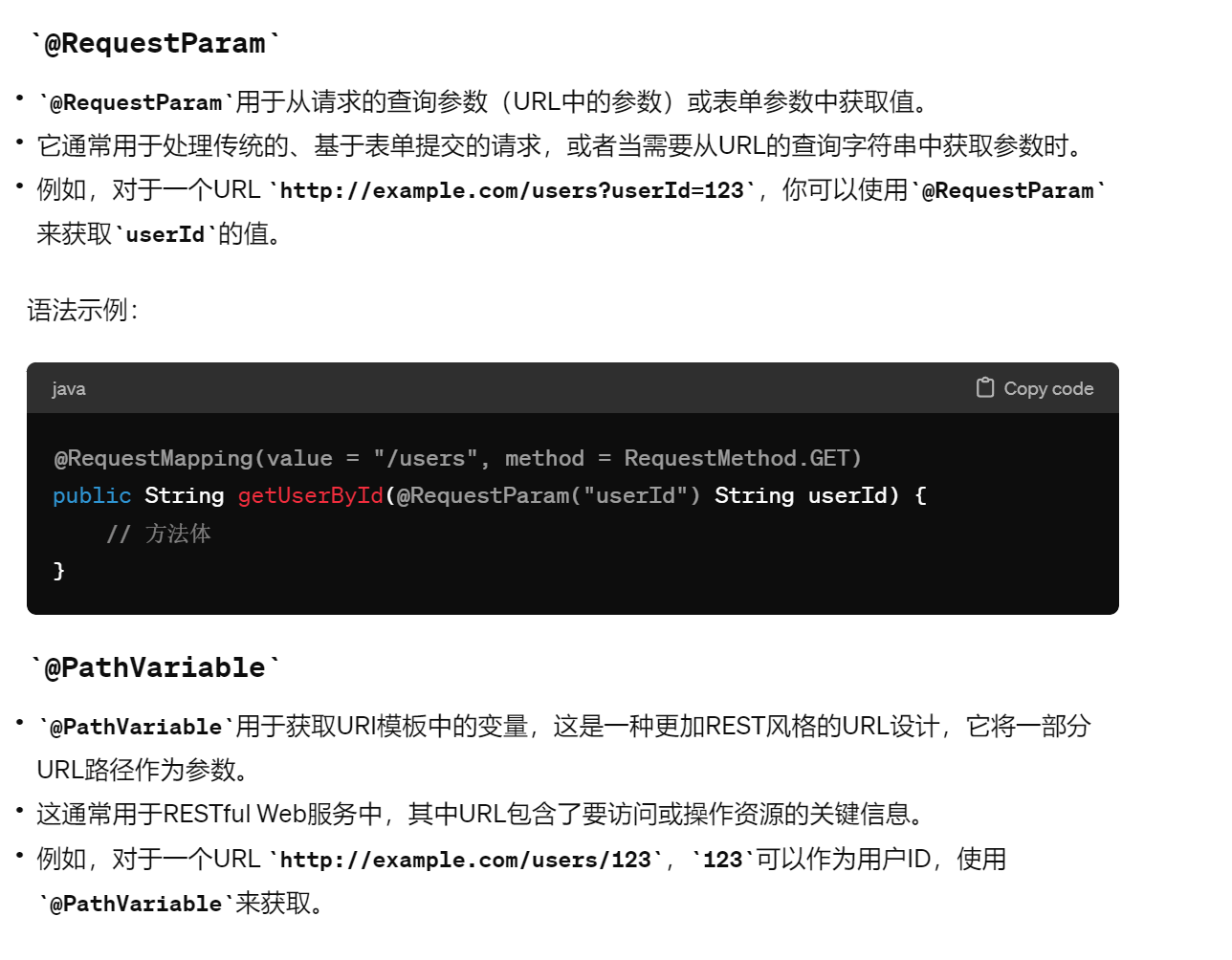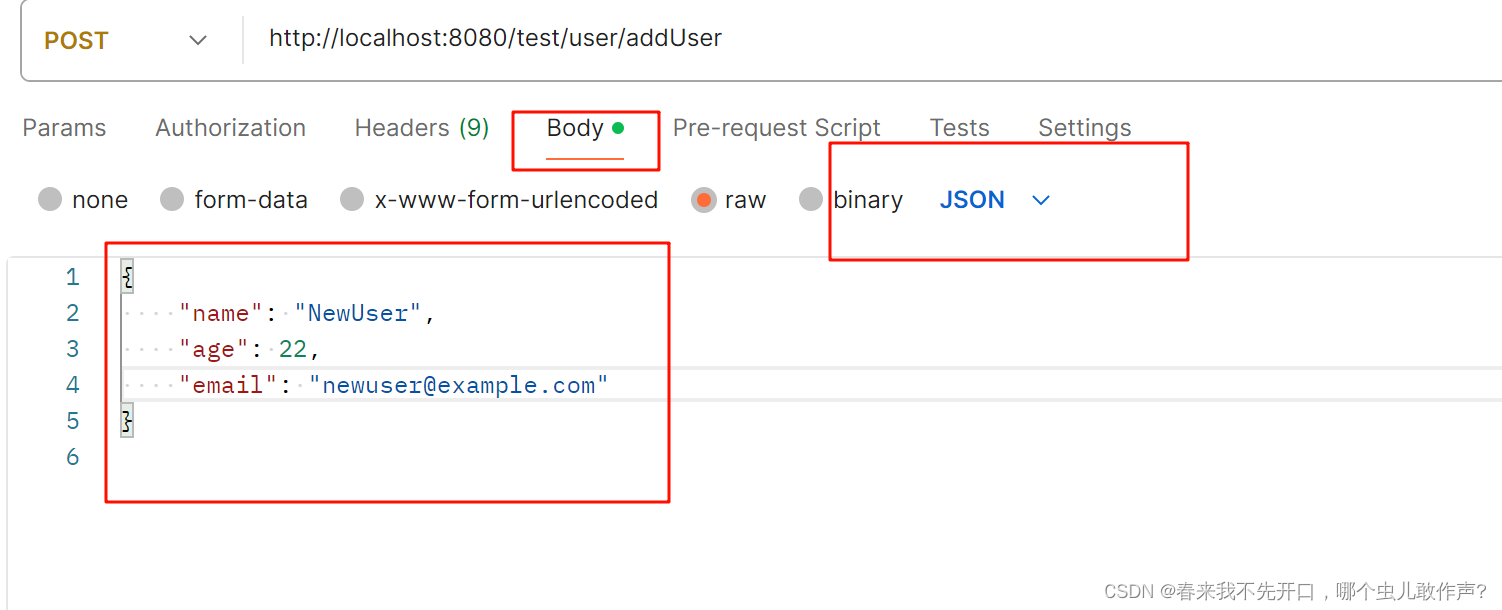requestparam专题
关于@RequestParam的主要用法详解
《关于@RequestParam的主要用法详解》:本文主要介绍关于@RequestParam的主要用法,具有很好的参考价值,希望对大家有所帮助,如有错误或未考虑完全的地方,望不吝赐教... 目录1. 基本用法2. 默认值3. 可选参数4. 绑定到对象5. 绑定到集合或数组6. 绑定到 Map7. 处理复杂类
基于@RequestParam注解之Spring MVC参数绑定的利器
《基于@RequestParam注解之SpringMVC参数绑定的利器》:本文主要介绍基于@RequestParam注解之SpringMVC参数绑定的利器,具有很好的参考价值,希望对大家有所帮助... 目录@RequestParam注解:Spring MVC参数绑定的利器什么是@RequestParam?@
SpringMVC_005_@RequestParam @RequestHeader @CookieValue
handler method 参数绑定常用的注解,我们根据他们处理的Request的不同内容部分分为四类:(主要讲解常用类型) A、处理requet uri 部分(这里指uri template中variable,不含queryString部分)的注解: @PathVariable; B、处理request header部分的注解: @RequestHeader, @Cookie
@RequestBody与@RequestParam:Spring MVC中的参数接收差异解析
在Spring MVC中,@RequestBody和@RequestParam是两个常用于接收客户端请求参数的注解,但它们的使用场景和作用机制存在显著差异。了解这些差异对于开发RESTful API和处理HTTP请求至关重要。本文将详细探讨@RequestBody与@RequestParam的区别。 @RequestParam @RequestParam注解用于将HTTP请求中的参数(包括UR
@PathVariable@RequestBody和@RequestParam区别
其他见https://blog.csdn.net/weixin_38004638/article/details/99655322
springboot3 controller中的参数 本地开发可以正常注入,但是打包到生产后就无法识别,必须使用@RequestParam后才可以识别问题解决
问题 在Controller代码中声明了一个参数,本地可以正常注入: @RestControllerpublic class TestController {@GetMapping("test")public String test(String testParam) {return "test" + testParam;}} 在本地 访问 GET http://localhost:8
springmvc学习笔记(5)——RequestParam
RequestParam也是一个非常常用的注解,它用来获取参数值,相当于request.getParameter("key")的作用。直接上代码: /*** * @RequestParam 映射请求参数 * required 是否是必传参数,默认为true* defaultValue 参数默认值*/@RequestMapping("/testRequestParam")public Str
@RequestParam注解
Spring MVC 通过分析处理方法的签名,将 HTTP 请求信息绑定到处理方法的相应人参中。 Spring MVC 对控制器处理方法签名的限制是很宽松的,几乎可以按喜欢的任何方式对方法进行签名。 必要时可以对方法及方法入参标注相应的注解(@PathVariable、 @RequestParam、 @RequestHeader 等)、 SpringMVC 框架会将 HTTP 请求的信息绑定到
@RequestParam,@PathVariable区别
@RequestParam 和 @PathVariable 注解是用于从request中接收请求的,两个都可以接收参数,关键点不同的是 @PathVariable 是从一个URI模板里面来取值(/后面?之前) @RequestParam 是从request里面取值(?之后) @RequestParam 支持下面四种参数 defaultValue 如果本次请求没有携带这个参数,或者参数
【Java】@RequestParam 提示400,Required Long parameter 'xx' is not present
主要原因是 getItemCatList(@RequestParam("id")Long parentId) 用@RequestParam("id")会让Required默认为true,就必须要提供一个值 而此时,网页原本就没有传入这个值到Controller的需求 所以需要设置一个默认值defaultValue="xx"即可解决问题
解决Valid在@RequestParam场景不生效的问题
项目场景: 最近帮同事在看一个后端接口数据关于类型、长度、字符内容规范化的任务,想到了使用Valid注解的方式来完成,但是在实际使用的时候,发现前后端数据在不同场景下交互方式的差异,会导致Valid注解使用不生效。 问题描述 @RequestParam数据校验不生效: public JsonResult createApplication( @NotBlank @Size(min =
@RequestParam和@PathVariable的区别和使用
@RequestParam 和 @PathVariable 注解是用于从request中接收请求的,两个都可以接收参数,关键点不同的是@RequestParam 是从request里面拿取值,而 @PathVariable 是从一个URI模板里面来填充 @PathVariable 主要用于接收http://host:port/path/{参数值}数据: http://localhost:88
requestbody requestparam pathvariable前端端实战,让你彻底了解如何传值
requestbody requestparam pathvariable前端端实战,让你彻底了解如何传值 前言 这个文章分为原理篇和实战篇,如果你只想知道如何使用,可以直接跳转到实战篇,这里会用springboot3加vue3来演示如何进行一个传值。 原理篇 首先用一个最简单的图来说明他们的区别: 注解用途常见应用场景@RequestBody从请求体中提取数据,通常用于获取JSON或X
requestParam requestBody注解
post请求使用 RequestBody注解 一个方法体中的参数只能有一个RequestBody注解 @Validated @Valid @NotNull 没有值时,Integer给个null int给个0(int默认值是0) RequestParam的使用 https://jingyan.baidu.com/article/546ae185c816641148f28c66.html
SpringMVC 请求 响应( @RequestMapping、@PathVariable、@RequestParam等注解)
MVC请求 支持ant风格的路径 ?:表示任意的单个字符*:表示任意的0个或多个字符**:表示任意的一层或多层目录 注意:在使用**时,只能使用/**/xxx的方式 @RequestMapping 用于建立请求 URL 和处理请求方法之间的对应关系 位置: 类上,请求URL 的第一级访问目录。此处不写的话,就相当于应用的根目录方法上,请求 URL 的第二级访问目录,与类上的使用@Re
SpringMVC注解类@RequestParam结合extjs的使用示例。
SpringMVC注解类@RequestParam结合extjs的使用示例。 java: @ResponseBody @RequestMapping(value = "/address", method = RequestMethod.POST) public List<Map<String,String>> address(@RequestParam("c") String colu
在SpringBoot中@PathVariable与@RequestParam的区别
@PathVariable @GetMapping("/{userId}")public R<User> getUserById(@PathVariable Long userId) {return userService.getUserById(userId);} // 根据id获取一条数据function getStudentDataByIdAndDisplayInput(id)
@RequestParam和flashMessage
@RequestParam的应用,基本是应用到设置默认值。其他的要收集传过来的数据只需要与表单名字相同就行了。 第二个就是我们在添加、删除、编辑什么成功或者失败后应该要有所显示,这时就需要一个FlashMessage来帮助我们完成这些工作。它的工作机制就是: 添加数据的页面中,submit,Controller中将这个数据进行处理后,根据处理结果调用flashMessage类。这时候会碰
Axios传递参数后端用@RequestParam
Axios传递参数后端用@RequestParam: Axios请求头中的Content-Type常见的有3种: Content-Type:application/json: 请求体中的数据会以json字符串的形式发送到后端(Axios默认)Content-Type:application/x-www-form-urlencoded:请求体中的数据会以普通表单形式(键值对)发送到后端Conte
@RequestBody和@RequestParam区别以及对应postman中的传参方式
https://blog.csdn.net/weixin_38004638/article/details/99655322
SpringMVC之注解RequestParam、RequestBody
一、RequestParam 1.springmvc 方法中的注解RequestParam 1@RequestMapping("/remove.sdo")public void remove(HttpServletResponse response, @RequestParam(value = "adOrder") String adOrder)2@RequestMapping("/re
@RequestParam:将请求参数绑定到你控制器的方法参数上(是springmvc中接收普通参数的注解)
https://blog.csdn.net/sswqzx/article/details/84195043
@RequestBody、@RequestParam、@RequestPart使用方式和使用场景
@RequestBody和@RequestParam和@RequestPart使用方式和使用场景 1.@RequestBody2.@RequestParam3.@RequestPart 1.@RequestBody 使用此注解接收参数时,适用于请求体格式为 application/json,只能用对象接收 2.@RequestParam 接收的参数是来自HTTP 请求体
restTemplate.postForObject传递requestParam
标题有点恶心,描述不太清楚遇到的问题,现在来具体解释一下:首先定义项目A和项目B,A项目有个消息推送的接口,B有个主推也就是调A的接口的方法,前期A约定使用post,需要的参数也是somany。。。故B将请求的参数封装为一个requestBody进行参数传递,联调过程中,发现A接口的参数使用requestparam进行传递 解决思路: 将requestBody使用beanUtils.descr
详细分析Java中的@RequestParam和@RequestBody
目录 前言1. 基本知识2. 使用场景2.1 @RequestParam注解2.2 @RequestBody注解 3. 接口测试3.1 @RequestBody注解3.2 @RequestBody注解 4. 总结 前言 该知识点主要来源于SpringMVC:SpringMVC从入门到精通(全) 慢慢作为一名全栈,偶尔看项目使用@RequestParam或者@RequestBod














